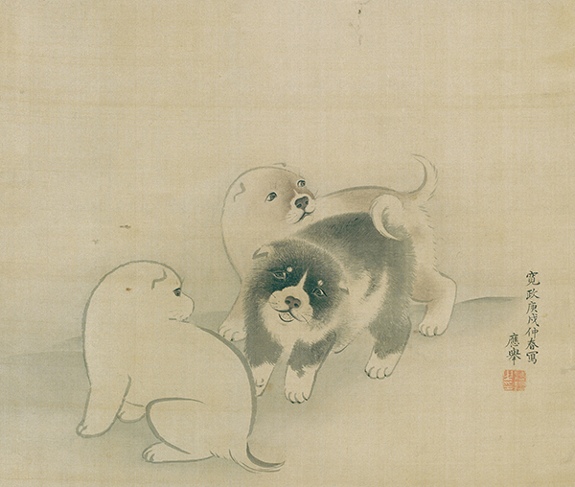August is National Dog Month: Maruyama Ōkyo
I recently learned that August is celebrated as National Dog Month. I’m all for a month dedicated to those loyal and darling fellow sentients! A well-known doggy treat maker announced the month-long celebration 2020. There is precedent for celebrating dogs as National Dog Week has occurred during the last week of September since 1928. Let’s not forget that International Dog Day is the 26th of August, as well. I can’t think of a more fitting tribute to the month than this Maruyama Ōkyo painting!
 |
| Maruyama Ōkyo (1733–1795, Japan), Three Puppies, 1790. Ink and colors on silk, mounted as a hanging scroll, 15 3⁄16" x 17 15⁄16" (38.6 x 45.5 cm). © 2024 Philadelphia Museum of Art. (PMA-3017) |
The artwork Three Puppies is an unusual one in Ōkyo’s body of work. The puppies are defined mostly by contour lines—the dog in the foreground is drawn almost completely as a simple outline. Only the sophisticated delineation of the fur of the middle dog indicates that this is indeed Ōkyo’s work. The lack of background may indicate that the way the puppies are drawn is symbolic rather than representational, although Ōkyo seems to have based his painting on the observation of specific dogs. Dogs are one of the twelve zodiac signs in Japan. They are also symbols of good health. Young children are often described as being “healthy as puppies,” leading to the custom of giving newborn babies a toy dog to play with as a charm to encourage healthy growth.
Born into a family of farmers, Ōkyo showed artistic talent at an early age. He apprenticed as a child at a clothing shop, painted dolls for a toymaker, and designed accessories in a cosmetics shop. Although he was not talented in the art form of calligraphy, he came to excel at painting. At the age of sixteen, Ōkyo entered the Kanō School, the official assemblage of painters for the upper classes during the Edo period. There he became proficient in the conservative school’s major art forms of monochromatic, Chinese-influenced scroll painting and screen painting in the traditional Japanese style of yamato-e. This style is typified by flat, decorative colored shapes from nature against gold leaf backgrounds.
Ōkyo’s personal style was based on direct observation, which was probably influenced by the landscapes surrounding his family’s farm. The Western artistic influence that emerged in Japan during the late 1700s included one-point perspective and chiaroscuro (defining volume through built-up nuances of lights and darks). As Ōkyo’s career progressed, he came to reject the abject stylization of Kanō painting. He and a group of other artists formed the Shijō school, adopting Ōkyo’s realistic style and the direct observation of nature. The group was named after Shijō Street in Kyoto, where many of the artists had their workshops.
And in case Ōkyo’s work is not cute enough, how about this doggy by ceramic sculptor David Gilhooly?
 |
| David Gilhooly (1943–2013, U.S.), Pink Terrier, 1968. Glazed ceramic, height: 17" (43 cm). Private Collection, California. Image courtesy of the late artist, © 2024 Artist or Estate of Artist. (8S-21603) |
Gilhooly was born in Auburn, California. At the same time that Pop Art developed in New York during late 1950s to early 1960s, the West Coast developed its own unique version that emphasized technique more than elevations of common objects. Gilhooly was a member of a group of avant-garde artists in Davis, California. These artists did not consider themselves “mainstream” Pop artists. Personal fantasy, often on the raunchy side, was a major component of West Coast Pop.
Correlations to Davis programs: Explorations in Art 2E Grade 1: 4.8, 4.9; Explorations in Art 2E Grade 2: 3.1, 3.2; Explorations in Art 2E Grade 3: 2.5, 2.6, 5.1, 5.2, 5.3; Explorations in Art 2E Grade 4: 2.7, 4.2, 4.3; Explorations in Art 2E Grade 5: 4.4, 4.5, 4.6; Explorations in Art 2E Grade 6: 2.4, 2.5, 2.6, 2.8; Experience Art: 4.2; A Global Pursuit 2E: 5.3; Discovering Drawing 3E: chapter 8

Comments